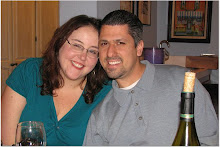As many of you know, I am descended from the Jews of Spain (at least on my mother’s side – hence my label of half-breed) who were either forced to convert or leave their homes in 1492. Many chose to leave, while some decided to hide the fact they were Jewish, practicing in secret – these were called Conversos (it used to be Moranos, but it has been changed, as Moranos means pigs). There are still stories of families in Spain today who are finding out that they were, at one point, Jewish.
Now, over 500 years later, it is amazing what has been inspired by the fact that we were forced to change our ways or put into exile – particularly when it came to culinary traditions.
I am inspired in part by my friend Sean, who told me the story of paella, a traditional Spanish dish of rice, saffron and a variety of unkosher meats, such as mussels, shrimp and chorizo. It turns out that this is not a coincidence. This dish was invented by the Conversos of Spain, so authorities would not suspect them of being Jewish and not investigate them further.
For those Jews who decided to leave, they moved to similar climates, such as Greece, Morocco and Turkey, where my family hails from, so their diets weren’t changed as dramatically. However, the difference in the diet of the Sephardim is very obvious to the Ashkenazim, as there is a lot more emphasis on dairy and fish. My family did eat meat, but it wasn’t as frequent as a fish dish. Also, there was a stronger emphasis on fresh vegetables, eggs and cheese.
They combined the flavors of their parts of the world with the traditions of the Jewish people. For example, for a fish dish that was served on Friday night or for Shabbat lunch in Greece and Turkey, they used the fresh fish that was caught near their homes and turned it into pescado con huevo y limon, which was served cold. The Moroccan Jews served meat, particularly for festivals, but they used the flavors that were around them, from the dried apricots and sour cherries to the variety of spices, to make their meats special.
We took our flavors with us wherever we went, even to America, where the concept of Jewish life up until very recently was viewed almost exclusively as Asheknazi. It would make sense – out of 7 million Jews in the U.S., it’s estimated only 500,000 are Sephardim. The concept of the Sephardim was not embraced as much (some even claimed we weren’t actually Jewish). It’s only been recently that the picture of Jews in the United States has changed. There is a ton of diversity, particularly here in Los Angeles where Jews hail from all over the globe and are of every skin color and race.
There is also the fact that the way we are looking at food is changing, and every person I know who is in the kitchen doesn’t want to just make brisket all the time. They want to experiment and try new things. Hence, the Sephardic way of cooking provides some fresh perspective. They love the fact that we have the Mediterranean diet working for us – filled with good fats yet good flavor. Combined with the fact that we provide a little history behind it is worth it. Our food is taking the beauty of the past and combining it with the relevance of today. It’s the Sephardic way of life.
It’s possibly one of the reasons why I stepped up to the plate to host a Sephardic cooking class today at the Alpert JCC in Long Beach. I think that it’s so important to share this food, to share our history and to share our lives. The truth of the matter is that when I will be cooking, generations of people will be standing behind me, knowing that our time has come at last.
So in honor of that, here is the recipe for biscochos, the traditional Sephardic cookie I will be making today. It’s the best when enjoyed with a cup of coffee. Enjoy!
BISCOCHOS
4 eggs
¼ cup milk
1 cup plus one teaspoon sugar
½ cup vegetable oil
4 ½ cups flour
4 tablespoons baking powder
1/2 teaspoon salt
1 cup sesame seeds
Preheat the oven to 350 degrees.
Beat the eggs. Set aside four tablespoons of egg. Add the milk, sugar and vegetable oil. Combine the flour, baking powder and salt. Add a little at a time to the wet mixture, combining each time.
Once it forms a smooth dough, roll strips of dough into ½ inch diameter. Cut each length into 4 inch pieces, and bring the ends together to make a circle. Slice the edges of each circle every ½ inch, and place on an ungreased cookie sheet. Add 1 teaspoon sugar to the remaining egg and brush on the cookies. Top with the sesame seeds.
Bake for 15-20 minutes, then broil for approximately 1 minute to brown. Take them out of the oven and allow it to cool. After 5-10 minutes, put the cookies back in the oven to dry out. Serve with a cup of coffee.
Quick Tip: There are variations of biscochos that have lemon or orange zest. I’m sure vanilla extract would add a great flavor to the cookies.

No comments:
Post a Comment